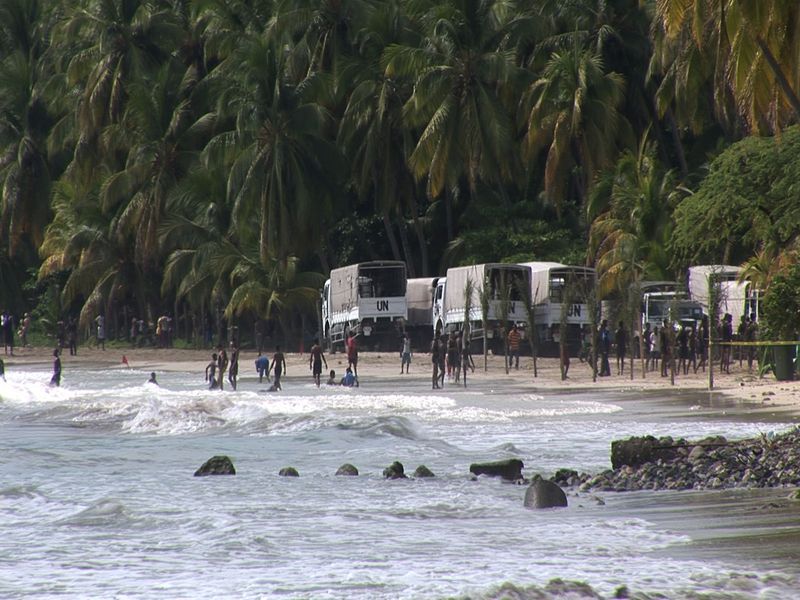When Royal Caribbean's Oasis of the Seas docked in Haiti yesterday, history was made. First, it marked the inaugural passenger sailing of the vessel, the largest in the world with capacity for 6,300 cruisers. Second, it was the first visit hosted by the newly renovated port at Labadee, Haiti's greatest hope for jumpstarting its fledgling tourist industry, representing an investment of 55 million dollars. Labadee has welcomed many Royal Caribbean ships over the years but until yesterday they did not dock and passengers were instead ferried in on launches.
For Haiti, Labadee is a big deal. It is the largest source of income from tourism in the country and provides a few hundred jobs for its workers and the merchants who come to the resort to sell art, crafts and souvenirs. In October, while on his third official visit to Haiti as the United Nation's special envoy to the Caribbean nation, Bill Clinton got a sneak peak at Labadee's new pier and upgraded facilities. In a blog post about showing the president around, Royal Caribbean Chairman Richard Fain wrote: "Our project at Labadee is a perfect example of just how powerful an economic engine tourism really is. President Clinton has been expressing similar comments publicly and we were encouraged by his efforts to bring economic and social progress to Haiti. It was a special privilege to be able to demonstrate our example of success in this arena." With a new pier to allow an even greater flow of tourists from boats as large as the Oasis of the Seas, Labadee is set to take on an even greater prominence for the ailing Haitian economy.
But all this promise has not been without controversy: First has been the question of where passengers actually think they are when they visit Labadee. While Royal Caribbean marketing materials today clearly disclose Labadee's location as being in Haiti (a country for which the US State department still issues a travel warning), and offer the opportunity to "learn a bit about the Haitian culture", the company does not appear to have always been so keen to market Haiti. A February, 2005 400-word press release about the opening of a new water park at the facility makes no mention of Haiti at all but does include this description: "Located on the mountainous, secluded north coast of Hispaniola, Labadee is a 260-acre wooded peninsula that features five spectacular beaches, nature trails, open-air dining areas, beachside bars, native entertainment and a marketplace complete with fine arts and crafts." An article in the Christian Science Monitor from 2006 featured interviews with several passengers who had no idea they were in Haiti (though, to be fair, very few appeared to care once told). One Royal Caribbean (RC) passenger, posting a review on the popular travel site TripAdvisor, however, was not so blasé about Labadee: "First off it's in HAITI but RC likes to say it's Hispaniola, which is technically correct because that is the island on which Haiti is located. It's always been an unstable and dangerous place to be. The area is fenced off by 10-12 feet fences patrolled by machine gun toting security."
Then there are political sensitivities surrounding the ownership of the resort. Royal Caribbean calls it a "private beach destination", but it has more colloquially been referred to as the company's "private island". This is technically wrong on both fronts: first, the resort is leased by Royal Caribbean from the government of Haiti. As in many countries, it is not possible for private entities to own actual coastline in Haiti. Nor is Labadee technically an island. It is an enclave fenced off from the rest of Haiti, with access for locals restricted. But misuse of the term "private island" by travel agents, travel writers and others has raised hackles inside Haiti, where, despite the jobs the resort has already brought, there are sensitivities over the idea that foreigners might own Haitian land and that local people are blocked from their nationally-owned seafront. An anti-government blog, in an entry about Labadee, calls Haiti "under occupation".
On our last day reporting from Haiti, we witnessed firsthand the sensitivities surrounding access to land, especially coastal land. Last Sunday, the United Nations' Sri Lankan battalion, serving as peacekeepers in Haiti, enjoyed a beach outing near the southern port city of Jacmel. Hundreds of soldiers, out of uniform for the day, frolicked in the surf and feasted from the barbecue. But nearby, some Haitians looked on with disdain, noticing a small plastic fence erected around at least parts of the site and armed soldiers standing along the main road. "It's not right, they can enjoy our beach but they can't block it," said one local man, nursing a Prestige beer at a nearby café, "I called the mayor myself to complain."
In the end, such concerns are likely to evaporate in face of the economic realities of Haiti. With an estimated 80% unemployment, jobs are much needed. The tourism potential in Haiti is enormous, with a unique culture and historic forts and pristine beaches all over. But the poor state of Haiti's infrastructure is such that reaching these spots is often a major chore. And until very recently, security has been a major concern. So in the short term, it may be the Labadee model that will prevail, giving the rest of the tourism sector time to catch up. As tour operator Jean Cyril Pressoir told the Christian Science Monitor, "It's not my favorite type of tourism, but I recognize that if we were smarter, we'd have 10 Labadees across the country."







